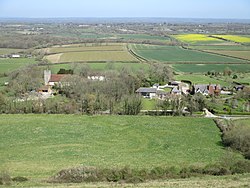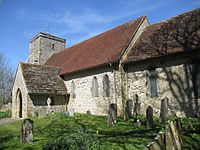Edburton
| Edburton | |
| Sussex | |
|---|---|
 Edburton seen from the South Downs | |
| Location | |
| Grid reference: | TQ233114 |
| Location: | 50°53’21"N, 0°14’53"W |
| Data | |
| Post town: | Henfield |
| Postcode: | BN5 |
| Dialling code: | 01903 |
| Local Government | |
| Council: | Horsham |
| Parliamentary constituency: |
Arundel and South Downs |
Edburton is a small village in Sussex, on the road from Upper Beeding to Fulking.
The name of the village is from the Old English Eadburga tun, meaning 'Eadburg's farmstead', after an ancient foundress of the village: who she was is not certain.[1] It is sometimes claimed that it refers to Edburga of Winchester, a granddaughter of King Alfred the Great and daughter of his successor King Edward the Elder.[2][3] In the Sussex dialect the village was called Aburton, as can be seen from the name of Aburton Farm, a farmstead now converted to housing.
Contents
St Andrew's church
The parish church, St. Andrew's, was rebuilt in the late twelfth century, in late Norman and Early English style, beginning with the nave and finishing with the tower. The interior stone came from Caen in Normandy. The well proportioned tower is mainly of flint.[4]
There is an unusual lead font in the church, with a raisable conical wooden cover. A round stone sink with Anglo-Saxon carving, which was found in the churchyard, is believed to be the piscina of the original Anglo-Saxon church. There are three mass-clocks or sundials carved into the stone on the south side of the church. These originally had a projecting metal rod called a gnomon or style to cast a shadow, and were used to divide up the day before clocks existed. A fourth mass-clock on the north side of the church sees no sunshine and is upside down, showing that the stone was reused from the earlier church, which was built around 940.
On either side of the communion table are two confession]] windows used by Franciscan friars]] to hear confessions when they were forbidden to hear confessions in church and people knelt outside the windows. The pulpit and chancel rails were given by Archbishop Laud. Stained glass windows are by James Powell and Sons and the East window was made by the Royal Bavarian Stained Glass Manufactory, Munich.[4]
From 1705 to 1716, the rector of St. Andrew's was George Keith, who had lived a tumultuous life: born in Scotland and raised a Presbyterian, he converted to Quakerism, settled in Pennsylvania and became a leading minister there during the late 1680s and early 1690s, until he began to condemnb the coloy's ruling Quakers and was expelled from the Society of Friends, whereupon he published a tract excoriating Pennsylvania;s Quakers for their involvement in slavery. Therafter he became a Church of England minister and a missionary travelling the world, until his quiet retirement as rector of Edburton.[5]
History
The church supposedly founded by Edburg around 940 at Edburton collapsed and was rebuilt in the late twelfth century on the same foundations. This indicates that there was a substantial population living where there are only a few houses now.
The situation at the foot of the north-facing South Downs escarpment provided a year-round supply of clean spring water from the chalk of the downs. The geology of Edburton varies. Farmers benefitted from the fertile and easily worked sandstones such as the Lower Greensands and the Grey Chalk of the Downs, but there are areas of sticky Gault Clay that are far more difficult to work and, as is often true in the Sussex Weald, these are where the best ancient woodlands can still be found.
Edburton Stream to Edburton Sands barns and brooks
The Edburton Stream is a chalk stream that runs by Edburton church to Edburton Sand barns and brooks. Lapwings breed in the fields around the stream. The brooks themselves are a wild place around a mile north of Edburton church with sedge and reed fen, willow carr and fine oaks on the bank. There is a huge three span girth pollard crack willow on the waterside. The fen has ragged-robin, greater tussock sedge, wood club rush, common sedge and both lesser and greater pond sedges. Downstream towards Catlands Farm are at least seven veteran crack and white willows. The area can support nightingale, cuckoos and other warblers.
References
- ↑ Ekwall, Eilert, The Concise Oxford Dictionary of English Place-Names. Oxford, Oxford University Press, 4th edition, 1960. p. 160 ISBN 0198691033
- ↑ "Edburton". Visitor UK. http://www.visitoruk.com/Worthing/edburton-C592-V21645.html.
- ↑ Elwes, Dudley George Cary; Robinson, Charles J. (1876). A History of the Castles, Mansions, and Manors of Western Sussex. London: Longmans. p. 85. https://archive.org/stream/ahistorycastles00elwegoog#page/n128/mode/2up. Retrieved 21 April 2016.
- ↑ 4.0 4.1 St. Andrew's church guide, 2001
- ↑ Ethyn Williams Kirby, George Keith, (New York, 1943), 148-158.
